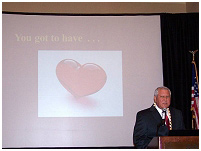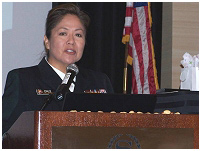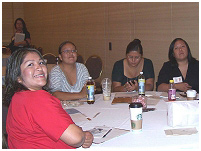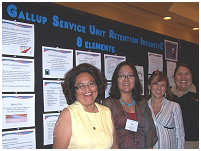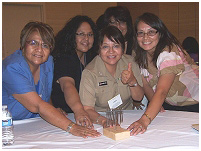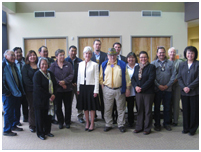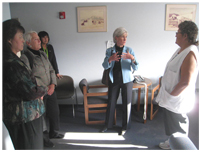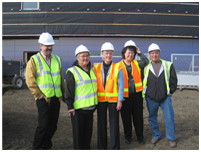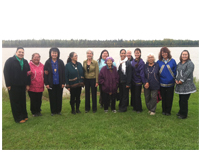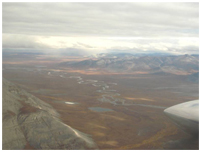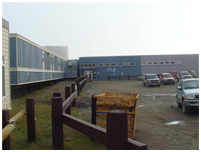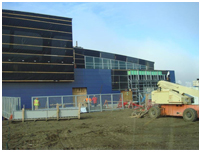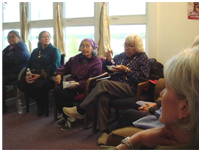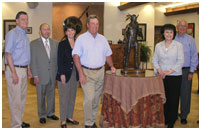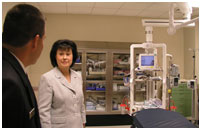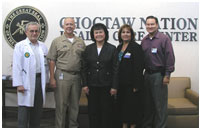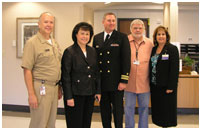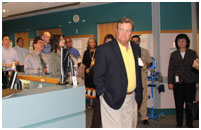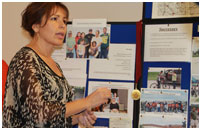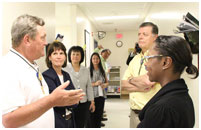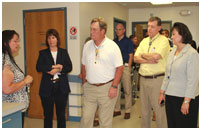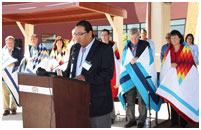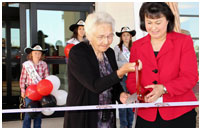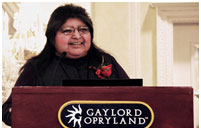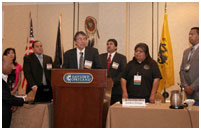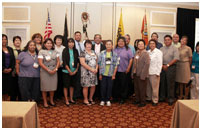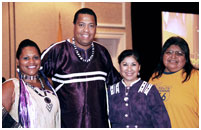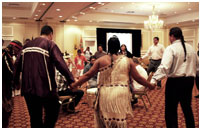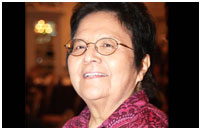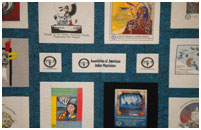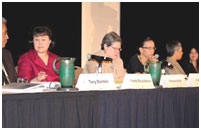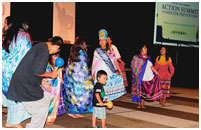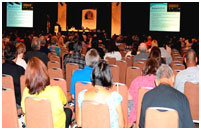September 2011 Blogs
Tribal Home Visiting Program - Grant Announcement
Thanks to the Affordable Care Act, families and children in tribal communities can get better and more personal care through the Tribal Home Visiting program. This program allows families to voluntarily receive home visits from nurses and social workers. These visits can help mothers and their newborns stay healthy, prevent child injuries and child abuse, neglect, or maltreatment. Working with families will also help ensure children are ready for school and prepared to learn. At the federal level, the program is administered through collaboration between my colleagues at the Health Resources and Services Administration (HRSA) and the Administration for Children and Families (ACF).
Since the Tribal Home Visiting Program began, over $10.5 million in grants have gone out to 19 Indian Tribes (including consortia of Tribes), Tribal Organizations and Urban Indian Organizations. Last year, 13 cooperative agreements totaling $3 million were awarded to tribes across the country, including:
- Choctaw Nation of Oklahoma (OK)
- Fairbanks Native Association, Inc (AK)
- Kodiak Area Native Association (AK)
- Lake County Tribal Health Consortium (CA)
- Native American Community Health Center, Inc (AZ)
- Native American Professional Parent Resources (NM)
- Northern Arapaho Tribe (WY)
- Port Gamble S'Klallam Tribe (WA)
- Pueblo of San Felipe (NM)
- South Puget Intertribal Planning Agency (WA)
- Southcentral Foundation (AK)
- White Earth Band of Chippewa Indians (MN)
- Yerington Paiute Tribe (NV)
This year, even more agreements are being awarded, totaling over $1.5 million, including:
- Eastern Band of Cherokee Indians (NC)
- Native American Health Center, Inc. (CA)
- Riverside-San Bernardino County Indian Health, Inc. (CA)
- Taos Pueblo (NM)
- United Indians of All Tribes Foundation (WA)
- Confederated Salish-Kootenai Tribes (MT)
The Tribal Home Visiting grants are quickly showing their potential to transform communities and support healthy, successful American Indian and Alaska Native children and families. In one grantee community, the energy generated by the needs assessment and the program caused an elder to proclaim that this program is what the community has been waiting for to bring hope for a better future. All of us at HHS are working to make sure that this important program reaches the communities that need it most, especially tribal communities, in order to improve the health and development of children and their families.
Understanding the Purchased/Referred Care Program: Part 6
Improving the Purchased/Referred Care (PRC) Program is a top priority and after consultation with Tribes, a federal/Tribal workgroup has developed some recommendations for improvements. [PDF - 138K] These recommendations include ensuring we document the total need for PRC funding, sharing best practices and improving the way we do business in PRC, understanding the impact of the PRC distribution formula when we get funding increases, and the need for more education about the program. In addition to the original recommendations submitted, the workgroup will be providing additional recommendations in the near future for consideration by the IHS Director.
Understanding the Purchased/Referred Care Program: Part 5
There have been some claims that IHS has not paid its bills to outside providers when they provide services to American Indians and Alaska Natives. While we are working on improving our payment process, it is important to understand that IHS does not pay for all American Indians and Alaska Natives who receive services in the private sector, and IHS also does not authorize all referrals or services for payment. Just like all other healthcare coverage, there are rules and regulations that require we ensure that we only pay referrals for eligible individuals and that those referrals were approved for payment through our process that includes the medical priority system. In addition, IHS is the “payer of last resort” by law, so IHS cannot pay for services unless any other possible healthcare insurance or coverage, such as private insurance, Medicare or Medicaid, has been applied for and/or used. We also enter into agreements with outside providers for special rates and services, and we do not pay full billed charges. We are working on making sure that outside providers understand we do not pay full billed charges and we do not pay for any services an American Indian or Alaska Native receives without prior authorization, confirmation of eligibility and payment from all other sources of coverage first. Patients should make sure that they understand if their referral or services are authorized for payment and, if not, work with our staff to make sure they have followed all the rules. Outside providers should work with IHS on understanding what we do and do not pay. This is a part of the business of healthcare – and all medical providers understand that not all billed charges are paid by insurance or other healthcare coverage and that there are rules to abide by. We will continue to work with our outside providers on improving the payment process; however, we will not pay for services that are not authorized for payment through our process and according to our policies and regulations. For more information, go to the Indian Health Manual, Part 2, Chapter 3.
Understanding the Purchased/Referred Care Program: Part 4
When a healthcare provider makes a referral for a patient to receive services outside the facility, the referral is reviewed to determine its relative medical priority. IHS regulations require that when funding is limited, referrals should be approved based on available funding and their medical priority. The PRC medical priorities are determined by a local committee that includes healthcare providers and administrators and meets weekly. In the past several years, due to funding limitations, IHS has in general only had enough funds to pay for the highest medical priority – Priority 1, or life or limb conditions. Patients who have referrals that rank below Priority 1 in general have not gotten their referrals authorized for payment due to limited funding. However, the increase in PRC funding we received last year has helped some patients with referrals in the category of Priority 2 get their referrals authorized for payment. Patients have expressed concern that some random administrator or employee is approving and denying referrals based on such factors as for relatives or friends. However, the PRC committee includes both clinical and administrative staff and they are to make decisions based on the medical reason for the referral. Some patients think we don’t want to pay for referrals; however, we would gladly pay for all referrals if we had enough funding to pay for them since we know that all referrals are medically needed. However, we must use the medical priority system to make sure that the limited funding is used for those most in need.
Understanding the Purchased/Referred Care Program: Part 3
Patients often wonder why even though their doctor made a referral for them to see a specialist or have a surgical procedure, it is not authorized for payment by the Purchased/Referred Care (PRC). IHS has regulations and policies that govern how to determine whether to pay for a referral or service in the private sector for our patients. If we had unlimited funding, we could pay for all referrals. However, since our PRC budget is limited, we must follow our regulations and the law to determine which referrals can be authorized for payment. In the simplest terms, the regulations tell us how to make sure the limited funding goes to those that need it the most. In a previous blog we discussed PRC eligibility, which is based on residence near the facility. There are also other considerations when funding is not available for all referrals, including timely notification of emergency room visits, prior approval and authorization for payment for referrals, the need to identify if patients are eligible for other healthcare coverage such as private insurance, Medicare or Medicaid, because by law they pay first before IHS, and whether funding is available to pay for the referral based on medical priorities. Here is a diagram [PDF - 251K] that helps understand the steps that occur to determine if IHS can pay for a referral or outside healthcare services. Clearly it is a complicated process and we are working on improving our business practices in this area.
Understanding the Purchased/Referred Care (PRC) Program: Part 2
IHS eligibility was established through legislation and IHS regulations. In general, American Indians and Alaska Natives who are members or descendants of federally-recognized Tribes are eligible for IHS direct services, which are services provided at our clinics and hospitals. However, the eligibility for the Purchased/Referred Care (PRC) Program (referrals to the private sector) is different. Years ago, Tribes wanted the limited budget of the PRC Program to benefit the patients who lived nearest to the clinical or hospital first. Therefore, PRC Program eligibility is based on IHS eligibility plus residence in the area around the clinic or hospital that is designated as eligible for PRC (also called the PRC Delivery Area, or PRCDA). That is why referrals are generally not approved for Tribal members who don't live on the reservation or Tribal lands associated with the hospital or clinic. Patients are upset that they lose their PRC eligibility if they move away from the reservation or Tribal lands and reside outside of the PRCDA. Again, this eligibility rule was put in place to make sure that the limited PRC funds benefit those who live closest to the clinic or hospital. Some say that we should make the PRC eligibility the same as IHS eligibility - that would mean more patients would be eligible. However, that would not mean that more patients would get referrals approved for payment because we still would have the same amount of funding in the PRC budget to use for more patients. And it could mean that individuals could travel to the clinic from another state, get PRC referrals paid for, and then travel back to the other state, potentially leaving no funding for patients who live in the Tribal community. Without additional funding, changing eligibility for PRC is a challenge. The next blog will cover how PRC referrals get approved for payment.
Understanding the Purchased/Referred Care Program: Part 1
This posting is the beginning of a series of postings on understanding the Purchased/Referred Care (PRC) Program. When IHS is unable to provide certain types of healthcare services directly in our hospitals and clinics, we may refer patients to receive services in the private sector. These referrals are paid for by the PRC program appropriations to IHS. However, the IHS PRC budget does not have enough funding to pay for all referrals that our healthcare providers make and our patients need. We are working actively with Congress to help them understand the enormous need for PRC funding to pay for needed referrals and to request increases in our appropriations for this purpose. The PRC budget is currently $779 million. That sounds like a lot, but the additional need for PRC referrals beyond what the budget pays for is an additional $861 million. Last year, we received a $144 million increase in PRC funding, and that has helped us pay for more referrals, but there still is a great need. We only received a small increase this year. We know that patients are upset that we cannot pay for all referrals, but we do try to pay for the most urgent referrals possible through our medical priority system. The next blog posts on this topic will explain the eligibility for PRC, what we do to determine if we can pay for a referral, and the medical priority system.
Nurse Leaders in Native Care Conference
I provided videotaped remarks for the Nurse Leaders in Native Care Conference in Albuquerque, NM. The conference emphasized how nurses can be leaders in helping the agency achieve its priorities and improve patient care. Here are some pictures from the meeting:
Click on the thumbnail for a larger image
Secretary Sebelius Visits Alaska
I traveled with Secretary Sebelius on a trip to Alaska at the end of August. The purpose of the trip was to visit Indian Health Service (IHS) and HHS funded facilities and programs. We started in Anchorage and the visits included Cook Inlet Tribal Council, Alaska Native Health Board, Southcentral Foundation, Alaska Native Medical Center, Alaska Native Tribal Health Consortium, Anaktuvuk Village, Barrow, AK and its IHS-funded hospital under construction, Tanana Community, and Tanana Chiefs Conference. The trip was a great opportunity for the Secretary to hear about best practices in tribal healthcare and to learn about ongoing challenges and issues. Here are some pictures from the visits:
Click on the thumbnails for larger images
Secretary Sebelius Letter to State Governors
Stacey L. Ecoffey, MSW, Principal Advisory for Tribal Affairs, Office of Intergovernmental Affairs at HHS sent out this email message with a copy of the Secretary’s letter [PDF - 74K] attached:
On Wednesday September 14, 2011 Secretary Sebelius sent a letter to State Governors regarding Tribal State Relations. The HHS Secretary’s Tribal Advisory Committee recently had a discussion with the Secretary regarding issues that they had with the States and HHS funding. As a follow-up to that conversation the Secretary sent the attached letter to States. The letter states her commitment to the government to government process and encourages states to consult with Tribes as they administer health and human service programs that are supported by federal funding. We wanted to ensure that you received a copy of the letter as well.
House Congressional Delegation
I traveled with members of the House Committee on Appropriations, Subcommittee on Interior, Environment and Related Agencies on a Congressional Delegation to Oklahoma and South Dakota in August. The purpose of the delegation was for the Chairman, Michael K. Simpson (Idaho), Representative Tom Cole (Oklahoma) and Representative Betty McCollum (Minnesota) to tour IHS funded health facilities and Department of Interior (BIA, BIE) funded projects. The Congressional Delegation visited the Chickasaw Nation, Choctaw Nation, Oglala Sioux Tribe, Rosebud Sioux Tribe, Cheyenne River Sioux Tribe and Standing Rock Sioux Tribe. We also attended the dedication of the new Cheyenne River Sioux Tribe Health Center that was constructed with ARRA funding. The trip was an opportunity to answer questions of the delegation members, show how appropriations are making a difference, and to explain the health needs of the communities served by our tribal and IHS facilities. The Subcommittee has been extremely supportive of the need for IHS funding increases and recently proposed a 10% increase in the IHS budget for FY2012. I am grateful to the Subcommittee for their support and the opportunity to accompany members on this delegation. Here are some pictures from the Congressional Delegation:
Click on the thumbnails for larger images
Direct Service Tribes Annual Conference
The Direct Service Tribes Annual Conference was held in Nashville, TN during the third week of August. The Direct Service Tribes receive health services under direct management of the Indian Health Service. The presentations included topics such as customer service, Purchased/Referred Care (PRC), revenue generation and third party billing, leadership, behavioral health, traditional healing and the Improving Patient Care initiative. I was so grateful to see the great spirit of partnership throughout the meeting. Here are some pictures from the meeting and a link to the conference website
Click on the thumbnails for larger images
Association of American Indian Physicians Annual Conference
I presented an update at the recent Association of American Indian Physicians Annual Conference in Portland, OR. The audience included American Indian and Alaska Native physicians, medical students, Indian health providers and program staff. The theme of the conference was SHARED VISIONS; BLENDING TRADITION, CULTURE, AND HEALTH CARE FOR OUR NATIVE COMMUNITIES. Here is a picture from the meeting of a quilt that was made for the 40th anniversary and was created with conference T-shirts that featured beautiful Native artwork from past years:
Click on the thumbnail for a larger image
Action Summit for Suicide Prevention
The Department of Health and Human Services (IHS and SAMHSA) and the Department of Interior (BIA and BIE) hosted the first Action Summit for Suicide Prevention in Scottsdale, AZ. This meeting was a result of Tribes requesting that federal agencies work together and collaborate with them to address this heartbreaking problem of suicides in Tribal communities. The agenda for this conference was informed by the 10 regional listening sessions that were hosted by HHS and DOI this past winter. The attendance was amazing (1000+) and indicated the significance of this topic and the need to take action. We are working on follow up from the meeting. Here are some pictures from the Summit:
Click on the thumbnails for larger images
Subscribe to get the blog by email:
Required fields are marked with an asterisk.
2024
2023
2022
2021
2020
2019
2018
2017



